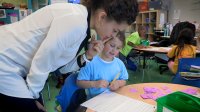Teachers Gain From Peer Review
Teachers share their students’ work with fellow teachers to improve their instruction.
Overview
Analyzing Student Work Data Protocol (PDF) allows Two Rivers Public Charter School in Washington, DC, to meet every student where they are in their understanding.
At least three times a semester, teachers meet to examine their students’ work and have it critiqued by a common planning team or by a team that spans across grade levels. This process can take anywhere from 25 to 35 minutes.
The outcome? Teachers leave with concrete steps on how to scaffold instruction to meet their students’ needs. “I love it,” says Taryn Peacock, a third-grade lead teacher. “It gives us an opportunity to see in depth what all the students in the class are doing.”
How It's Done
Choose Student Work to Analyze
Choose work that your students haven’t yet mastered so you can get feedback on how to best move forward. “We just started doing bar graphs with them last week,” says Peacock. “The process of looking at work will help me as I’m planning the rest of this sequence of lessons.”
Analyzing Student Work Protocol
1. Share the task (1 minute): Read the task to your colleagues. “We do this because we want to see if the task was worded in a way where students could understand it,” explains Peacock. “That’s why we don’t like to do too much of an explanation.”
2. Silent observation (4 minutes): After reading the task, have your peers examine the student work silently, and ask themselves:
- How would I respond to the task?
- How did students respond?
- How do we assess students on this task?
- What is a high-quality response to this task? (Useful for assessing students’ understanding against the exemplar, suggests Peacock.)
- What do I notice and wonder about the student work?
“You also want [your peers] to think about why students did things the way they did, as well as look at the nuances between their work,” advises Peacock.
3. Notice and Wonders (5 minutes): Your peers discuss their observations, questions, and what they notice about how student knowledge was assessed—no judgement or interpretation. The point is to notice patterns, like, “A lot of students included a title,” or “I notice that there are three different sets of numbers,” says Peacock. The presenter is silent during this time, taking notes.
4. Analysis and Judgement (5 to 10 minutes): Peers discuss their assessment of the task and student work, as well as solutions for addressing issues. The presenter is again silent during this time, taking notes. “I feel like there’s this profound vulnerability in being silent while your team looks at your work,” reflects Carolina Riveros-Ruenes, a middle school ELA teacher. “It also enables you to focus on what people are saying because you’re actively listening.” (See The Power of Vulnerability in Professional Development.)
To guide the discussion, Jeff Heyck-Williams, the director of curriculum and instruction, suggests answering the following questions:
- What does the student work tell me about student learning and thinking?
- In general, at what stage are students in their understanding with the content?
- What are next steps for teaching these students? What opportunities do they need to move their understanding and thinking from beginning to advanced?
- Is there a student or a group of students that have only basic or novice understanding? If so, what reteaching or scaffolding needs to occur? In what ways can we break down the concepts or skills to support these students?
- Is there a student or group of students that are advanced in their understanding? If so, what extensions need to be provided for them? How can they be challenged to deepen their thinking and understanding of the core concepts?
“We never say, ‘These students got it. We’ll just let them do whatever,’” emphasizes Peacock. “And we never say, ‘These students were behind, but we need to move on.’ It’s always, ‘How can we push the student, regardless of where they are?’”
5. Open discussion and suggestions (5 to 10 minutes): The presenter can join the discussion and answer questions. A lot of this discussion is centered around identifying and building on solutions, says Peacock:
- What are the next steps that students need?
- What is the confusion students have?
- How can we dig deeper into this work?
When analyzing student work, Peacock advises sorting it by understanding: students who finished the task and didn’t, students who mislabeled something, students who got something wrong. “We’re able to look at specific groups of students and see who was inaccurate with their scale, who didn’t have a very representative title, and what we need to do with them. We try to group students together so we can do differentiated, small-group instruction,” says Peacock. “Other times, I’ll get feedback based on a particular student. There were two students in particular who needed a lot more scaffolds and support in order for them to do the graph.”
6. Debrief (5 minutes): Everyone can make one last comment about the student work—reflecting on a takeaway—relating to the classroom of the presenting teacher, their classroom, or school-wide.
How would you adapt this protocol to fit your school and needs?
